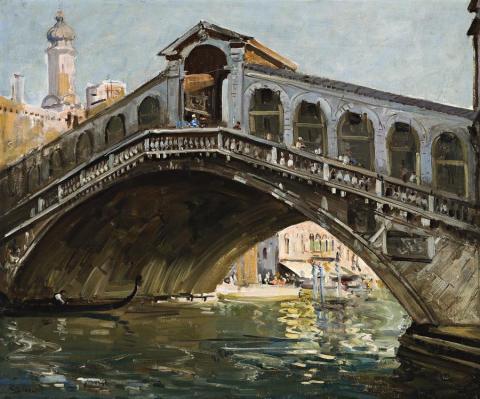THE RIALTO BRIDGE, VENICE, c.1908
ARTHUR STREETON
oil on canvas
62.0 x 75.0 cm
signed lower left: A Streeton
Collection of Major Harold de Vahl Rubin, Queensland
Christie's, Sydney, 4 October 1972, lot 423 (as 'Bridge of Sighs, Venice')
Collection of Lex Aitken and Alfredo (Bouret) Gonzalez, Sydney
Arthur Streeton, Alpine Club, Savile Row, London, 26 March – April 1909, cat. 41 (as 'Rialto Bridge'), 40 gns
Arthur Streeton's Venice, Guildhall, Melbourne, 13 – 27 July 1909, cat. 6 (as 'The Rialto Bridge'), 40 gns
Arthur Streeton's Exhibition of Paintings, Athenaeum Gallery, Melbourne, 24 August – 4 September 1937, cat. 7 (as 'Rialto Bridge')
The following two works show the Rialto Bridge from a different angle: The Rialto, Venice, from the Streeton sketch book 'Venetian studies spring + summer' 1908, pencil and wash on paper, 26.0 x 36.0 cm (sheet), collection of the Art Gallery of South Australia, Adelaide, gift of the artist 1943
Rialto Bridge, Venice, 1908, lithograph on paper, 25.4 x 34.3 cm, collection of the Art Gallery of South Australia, Adelaide, M.J.M. Carter Collection 1970
'What news on the Rialto?'1
Recalling Shylock's comment from Shakespeare's The Merchant of Venice, it is no surprise to learn that for centuries the Rialto was the financial and commercial centre of Venice, the Grand Canal here spanned by the magnificent Rialto Bridge. During his two visits to Venice in 1908, Arthur Streeton painted both the Rialto and its bridge. Until the mid-nineteenth century, the bridge was the only means of crossing the canal by foot. Wooden bridges had been there for centuries. When the last one was collapsing through decay, it was decided to hold a competition for the design of a new one, in stone. Although Michelangelo and Jacopo Sansovino were among the competitors, the commission was given to the appropriately named Antonio de Ponte (Anthony of the bridge). Completed in 1591 and regarded as something of an architectural miracle for its single span of stone, it was and still is one of the wonders of Venice. Like in design to the wooden one it replaced, the bridge, as seen in Streeton's painting, proudly strides the sparkling waters of the Grand Canal with its steeply inclined ramps leading up to the central portico, shops on either side.
A city of enchantment and water-borne splendour, Venice has always attracted lovers. Australian artists, like so many others, were not immune to its charms. Emanuel Phillips Fox and Ethel Carrick honeymooned there in 1907, painting many reminders of the city's numerous beauties in works that now grace the walls of our leading collections. The following year of 1908 Arthur Streeton and his bride Nora followed suit. Reports have it that while Streeton painted, Nora read Charles Dickens' Great Expectations. Many fine paintings resulted, Streeton capturing the beauty and wonder of its architecture bathed in the magical light of 'La Serenissima'. It was spring, Streeton returning in autumn - the two seasons when the romantic fairyland is at her most entrancing - to complete further paintings. In March of 1909 at London's Alpine Club, Streeton exhibited such treasures as Venice, Bride of the Sea (Carrick Hill, Adelaide), Blue Lagoon fringed round with Palaces, and Rialto Bridge, inspiring the art critic for the London Observer to write: '...Mr Streeton has caught the opalescent glitter of the Venetian canals and marble palaces in moments of bright sunshine as few artists have done before him ...'.2 Streeton cleverly cast the marble white of the Rialto Bridge in shade to enable the beauty of its detail and grandeur of its span to be better seen against the light on the canal waters and clear, sunny skies.
1. Shakespeare, The Merchant of Venice, Act 1, scene III
2. Observer, London, 4 April 1909, quoted in Galbally, A., Arthur Streeton, Lansdowne Press, Melbourne, 1979, p. 71
DAVID THOMAS
